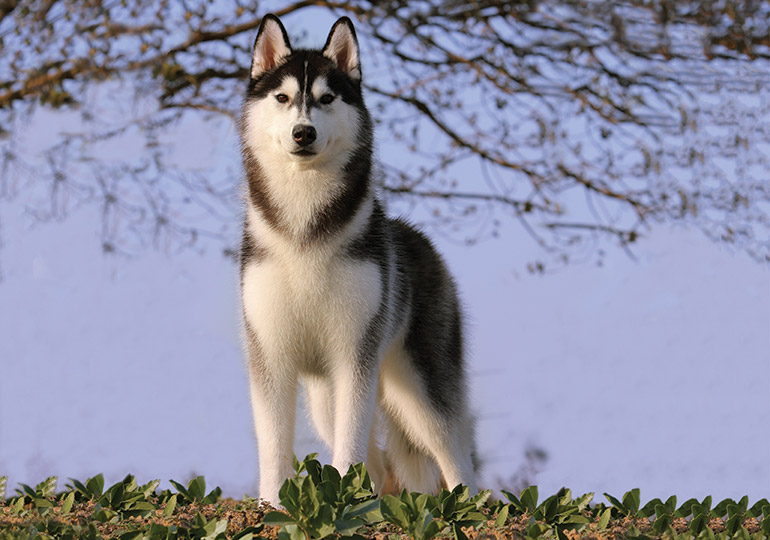Siberian Husky
Breed Details
Size:
Exercise Requirements:
Grooming Requirements:
23 kg (approx)
13 years (approx)

Appearance
Siberian Huskies are strong, compact, working sled dogs. The medium-sized head is in proportion to the body. The colour of the nose depends upon the colour of the dog's coat. It is black in gray, tan or black dogs, liver in copper dogs and flesh-coloured in pure white dogs. The medium-sized, oval-shaped eyes are moderately spaced and come in blue, brown, amber, or any combination thereof. The erect ears are triangular in shape, set high up on the head. The tail is carried over the back in a sickle curve, not curved to either side when the dog is excited. The large "snowshoe" feet have hair between the toes to help keep them warm and for gripping on ice. The medium length, double coat is thick. Coat colours include all from black to pure white, with or without markings on the head. The face mask and underbody are usually white, and the remaining coat is any colour. Examples of common colours are black and white, red and white, brown, gray and white, silver, wolf-gray, sable and white, red-orange with black tips, dark gray and white.
History
Siberian Huskies were used for centuries by the Chukchi Tribe, off the eastern Siberian peninsula to pull sleds, herd reindeer, and as a watchdog. They were perfect working dogs for the harsh Siberian conditions: hardy, able to integrate into small packs, and quite happy to work for hours on end. The dogs have great stamina and are lightweight. Native to Siberia, the Husky was brought to Alaska by fur traders in Malamute for arctic races because of their great speed. In 1908 Siberian Huskies were used for the first All Alaskan Sweepstakes, an event where mushers take their dogs on a 408-mile long dogsled race. The dogs gained popularity in 1925 when there was a diphtheria epidemic in Nome, Alaska. Siberian Huskies were used to bring in much-needed medicine to the people.
Temperament
Siberian Huskies are loving, gentle, playful, happy-go-lucky dogs who are fond of their families. Keen, docile, social, relaxed, and rather casual. This is a high-energy dog, especially when young. Good with children and friendly with strangers, they are not watchdogs, for they bark little and love everyone. Huskies are very intelligent and trainable.
Care/Grooming
Siberian Huskies need a fair amount of exercise, including a daily walk or jog, but should not be excessively exercised in warm weather. They need a large yard with a high fence but bury the wire at the base of the fence because they are likely to dig their way out and go off hunting.
The coat sheds heavily twice a year. During that time they need to be brushed and combed daily.

